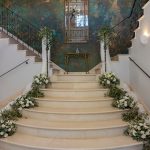An art exhibition, by its very nature, is unique, but, once in a while, a presentation of art is overwhelmingly impressive. Such is the Theatre of Life curated by Marci Gaymu and attended, at the opening ceremony, by the artist himself, António Saint Silvestre.
António Saint Silvestre’s art concentrates on sculptures depicting diverse events. Some are simple observations while others are politically motivated, making the observer realise that morality and human rights are abused on a worldwide scale.
The inauguration of the exhibition took place at the Museu de Portimão on 24 June and will run until 27 August. The event was introduced by José Gameiro, scientific director and founding member of the museum. A large group of collectors, art critics, gallery owners and journalists were in attendance.
Silvestre was born in Nampula, Mozambique. “Africans are amazingly inventive. They will find discarded items like sardine cans, bottles, some wire, scraps of wood, an old bicycle and, before you know it, a wonderful creation emerges,” explained the artist.
Years later, António moved to Portugal and attended the Colégio Académico de Lisboa, but he doesn’t attribute his artistic success to his education. “I am self-taught. I travelled widely; in my youth, I served in the military in Angola and I eventually found myself in Paris. My sculptures have been described as Baroque (emphasising dramatic, exaggerated motion and clear, easily interpreted detail). My first solo exhibition was in 1987.”

Having started a commercial gallery in Paris and maintaining it for some 25 years, Silvestre now has a gallery at the Centro de Arte Oliva in northern Portugal. The Centro de Arte Oliva is an art exhibition and collection management centre created in 2013 by the Municipality of São João da Madeira. It is the only artistic institution in the country dedicated to contemporary art and brut/outsider art. Thanks are due to Marci Gaymu for organising this wonderful event and bringing it to the Algarve.
As we walked around the exhibition, I asked António why there are no descriptions of his individual artistic creations. “My work represents controversial social issues and politically sensitive subjects. I create the pieces and let the observer decide their meaning and purpose.”

Many of the characters are dolls, so there can be no resemblance to real-life bad actors. The dichotomy of life is sometimes displayed with a cruel and horrific scene balanced with an angel or celestial image flying overhead.
The signature sculpture shows us the modern-day Portugal, complete with the shield and the national bird (rooster). Portugal’s progress under the direction of the dictator Salazar, depicted as a baby, is still controversial today. Looking at the detail, one sees the golden rabbit of prosperity eating people. Like many of the pieces, the message is in the detail.


Another interesting piece shows the world that football has reached the level of a religion, its players divine or God-like. Yet another clever depiction shows China’s subjugation of different races and the Chinese habit of eating domestic animals.
Each work is cleverly crafted, beginning with papier mâché. Then other materials come into play as the work demands. Resins, wood, plastic, tin and wire are just some of the ingredients.

The Barbie sculpture is derived from real life in China, where many females have notably short legs and a burning desire to become a Barbie look-a-like is paramount for some young ladies. An elaborate limb extending contraption can be applied and apparently has had some success.
In addition to the chair sculptures are furniture pieces, fixtures and unusual mobiles.
This exhibition is a must-see for lovers of contemporary art. It delivers a small slice of the theatre of life.













